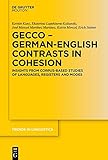GECCo - German-English Contrasts in Cohesion : Insights from Corpus-based Studies of Languages, Registers and Modes / Kerstin Kunz, Ekaterina Lapshinova-Koltunski, Katrin Menzel, Erich Steiner, José Manuel Martínez Martínez.
Material type: TextSeries: Trends in Linguistics. Studies and Monographs [TiLSM] ; 355Publisher: Berlin ; Boston : De Gruyter Mouton, [2021]Copyright date: ©2021Description: 1 online resource (XIV, 274 p.)Content type:
TextSeries: Trends in Linguistics. Studies and Monographs [TiLSM] ; 355Publisher: Berlin ; Boston : De Gruyter Mouton, [2021]Copyright date: ©2021Description: 1 online resource (XIV, 274 p.)Content type: - 9783110711059
- 9783110711097
- 9783110711073
- Contrastive linguistics
- English language -- Grammar, Comparative -- German
- German language -- Grammar, Comparative -- English
- Deutsch
- Englisch
- Kontrastive Linguistik
- LANGUAGE ARTS & DISCIPLINES / Linguistics / General
- Contrastive Cohesion
- Contrastive Linguistics English-German
- Corpus-Based Methodologies
- Register Variation
- 410 23
- P134 .K86 2021
- P134 .K85 2021
- online - DeGruyter
- Issued also in print.
| Item type | Current library | Call number | URL | Status | Notes | Barcode | |
|---|---|---|---|---|---|---|---|
 eBook
eBook
|
Biblioteca "Angelicum" Pont. Univ. S.Tommaso d'Aquino Nuvola online | online - DeGruyter (Browse shelf(Opens below)) | Online access | Not for loan (Accesso limitato) | Accesso per gli utenti autorizzati / Access for authorized users | (dgr)9783110711073 |
Browsing Biblioteca "Angelicum" Pont. Univ. S.Tommaso d'Aquino shelves, Shelving location: Nuvola online Close shelf browser (Hides shelf browser)
Frontmatter -- Acknowledgements -- Contents -- List of Tables -- List of Figures -- 1 Introduction -- 2 Conceptual clarification of cohesion -- 3 Methods for the contrastive investigation of cohesion -- 4 Systemic comparison -- 5 Assumptions and hypotheses -- 6 Corpus linguistic comparison -- 7 Contrastive summary -- 8 Implications for teaching -- 9 Discussion and outlook -- Bibliography -- Index
restricted access online access with authorization star
http://purl.org/coar/access_right/c_16ec
In contrastive linguistics of English and German, there is a tradition of accounting for contrasts with respect to grammar and, to a lesser extent, for lexis and phonetics. Moving on to discourse and text, there is a sizeable body of literature on cohesive patterns in English and German respectively - but very little in terms of a comparison. The latter, though, is of particular interest for language learners, translators and, of course, linguists and researchers in language technology. This book attempts to close this gap, based on a number of years of corpus-based study into variation and cohesion in the two languages. While there is an overall focus on language contrasts, it also investigates variation between different registers language-internally, and between written and spoken mode in particular. For each of the five major types of cohesion (co-reference, substitution, ellipsis, conjunctive relations and lexical cohesion), overviews are given of contrasts in the system and of contrastive frequencies in texts. Results and methods presented in this book are thus relevant for language teaching, translation, language technology and corpus-based work on English and German generally.
In der kontrastiven Linguistik Englisch-Deutsch gibt es bisher Vergleiche auf den Ebenen der Grammatik und in geringerem Umfang der Lexik und der Phonetik. Was den Bereich von Text und Diskurs angeht, so finden wir eine breite Literatur zu kohäsiven Mustern in den Einzelsprachen Englisch und Deutsch - aber sehr wenig zum Kohäsionsvergleich. Letzteres aber ist von beträchtlichem Interesse für Sprach- und Übersetzungsdidaktik, und natürlich für Sprachwissenschaft und Sprachtechnologie. In der hier beschriebenen Monographie wird der Versuch unternommen, die erwähnte Forschungslücke zu schließen. Der präsentierte Vergleich von Textmustern im Englischen und Deutschen ist das Ergebnis mehrjähriger empirischer Arbeiten zu Variation und Kohäsion in den beiden Sprachen. Dabei liegt der Schwerpunkt auf dem Sprachkontrast, daneben aber auch auf sprachinterner Register- und Modusvariation. Für alle fünf Haupttypen von Kohäsion (Koreferenz, Substitution, Ellipse, Konnexion und lexikalische Kohäsion) werden Vergleiche auf Systemebene, aber auch von Frequenzen im Text vorgenommen. Ergebnisse und Methodik der hier beschriebenen Arbeit sollten von Interesse sein für Sprach- und Übersetzungsdidaktik, darüber hinaus aber ganz allgemein für korpusbasierte Forschung zum Deutschen und Englischen.
Issued also in print.
Mode of access: Internet via World Wide Web.
In English.
Description based on online resource; title from PDF title page (publisher's Web site, viewed 25. Jun 2024)









